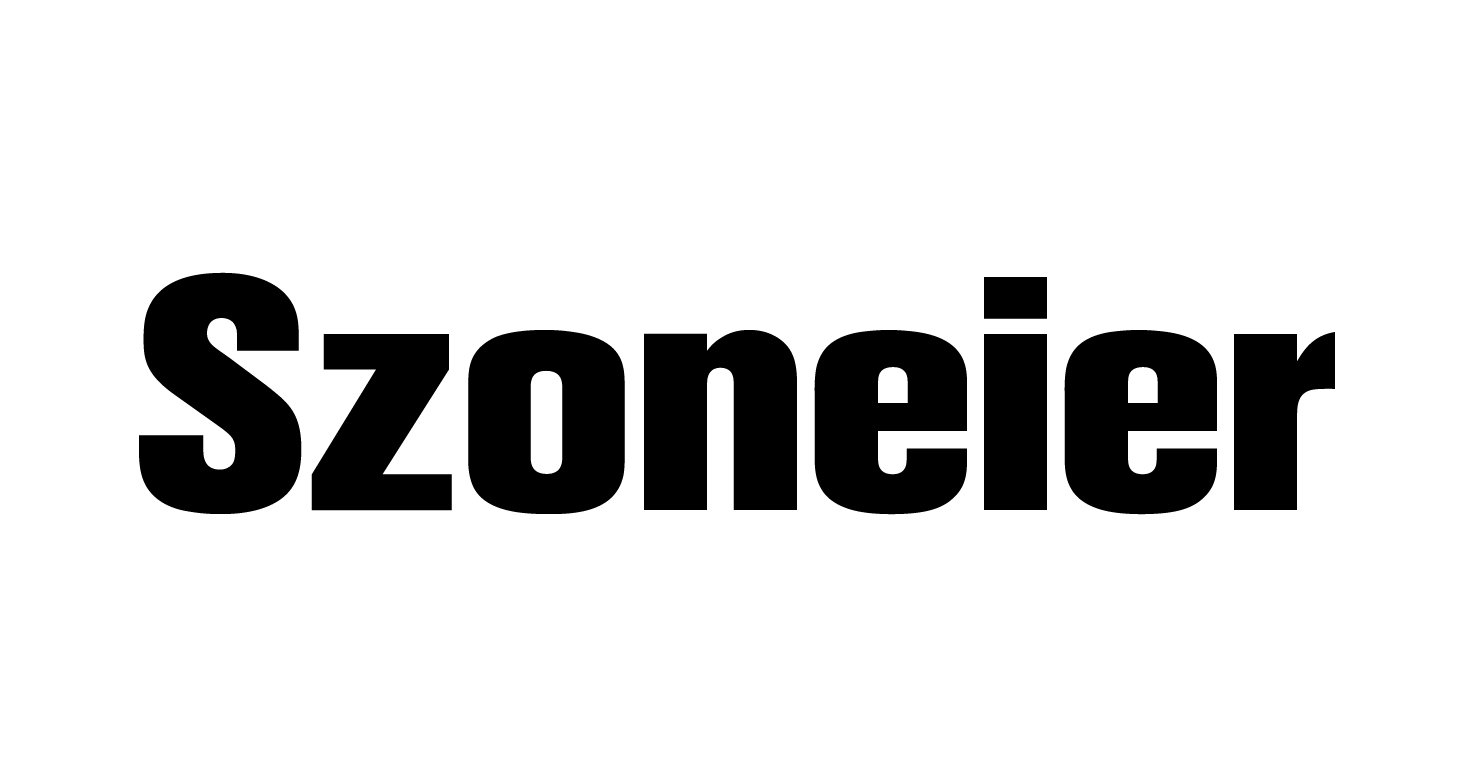Denim is no longer just about jeans—it’s about performance, sustainability, innovation, and identity. In 2025, top denim fabric manufacturers are not merely weaving cotton; they are engineering fabrics that meet rising global expectations for comfort, eco-friendliness, stretch performance, and brand-driven customization. From Japan’s heritage shuttle looms to China’s reactive-dyed selvedge denim to India’s organic cotton mills, the denim world is richer, faster, and more tailored than ever before. The best denim fabric manufacturers in 2025 are defined by consistent fabric quality, flexible customization, low MOQ options, sustainable certifications, and proven export capabilities. They serve global fashion and lifestyle brands with innovative, high-performance, and environmentally responsible denim solutions.
One Australian startup shared that their entire premium denim line succeeded not because of their marketing—but because their supplier delivered the perfect midweight stretch denim with just the right fade at a 200-meter MOQ. That’s the power of choosing the right denim manufacturer.
So, where are the best mills? And what makes one supplier better than the next? Let’s take a closer look.
What Qualities Define a Top Denim Fabric Manufacturer in 2025?
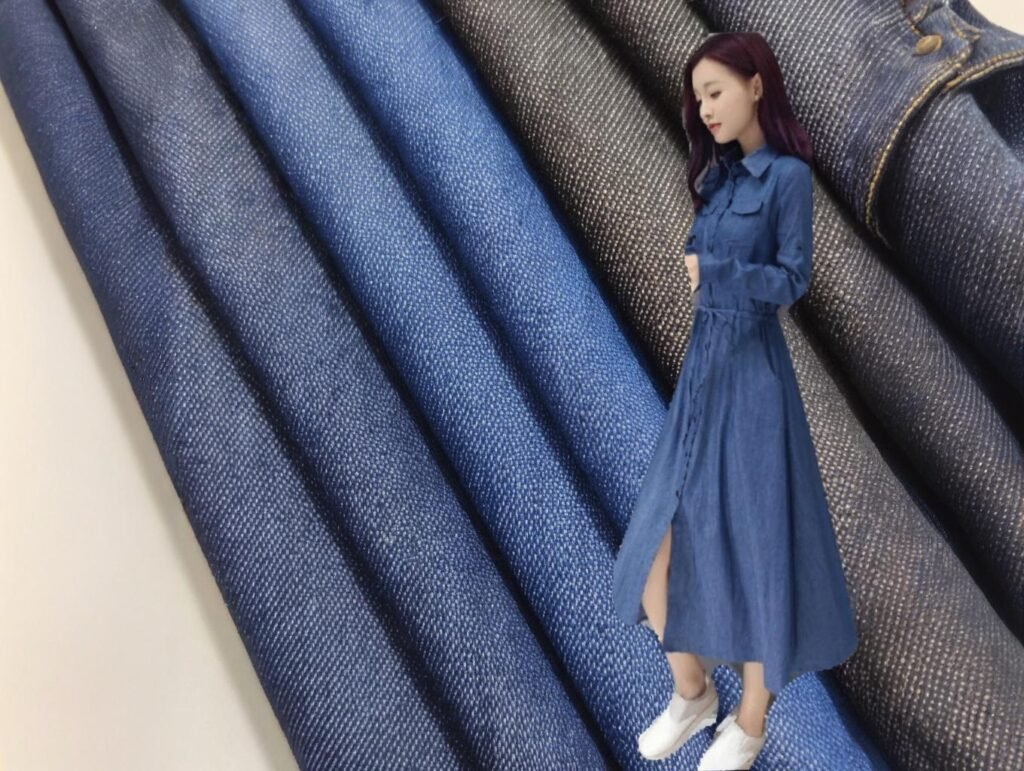
The best denim manufacturers in 2025 go far beyond basic supply. They act as partners in innovation and brand development, offering tailored solutions for today’s ever-evolving fashion, interior, and workwear markets. Whether you’re producing designer jeans, utility aprons, or hybrid urbanwear, the top denim suppliers combine consistency, sustainability, and commercial adaptability into a reliable sourcing experience. A top denim fabric manufacturer in 2025 is defined by fabric consistency, low MOQ flexibility, custom finishes, certified sustainability, fast sampling, and experience working with global fashion brands.
What Buyers Should Look For
Fabric Consistency & Quality Control Matter More Than Ever
Fabric shrinkage, skewness, and color variation can ruin entire collections. Top-tier denim mills have invested in laser width controllers, automatic tension feeding systems, and 4-point inspection setups to reduce error margins below industry benchmarks.
| Quality Metric | Top Manufacturer Standard (2025) |
|---|---|
| Shrinkage Control | ±3% after washing |
| Width Tolerance | ±1 cm |
| Indigo Dye Uniformity | ≥ Grade 4 (Blue Scale) |
| Skewness Correction | ≤ 3% on stretch denim |
| Defect Tolerance (4-Point) | Max 10 points per 100 yards |
This level of precision ensures that what the client receives is not just fabric—but production-ready input that meets global QA requirements.
Customization: Not Just a Value-Add, But a Buyer Expectation
Modern denim buyers expect fully customizable solutions—both in material performance and branding aesthetics. Leading mills support:
- GSM Ranges from 6.5 oz light denim for shirts to 14 oz rugged denim for jackets and workwear.
- Yarn Options: Cotton-rich rigid, dual-core stretch, TENCEL blends, or even anti-static yarns for utilitywear.
- Specialty Finishes: Enzyme-wash-ready fabrics, ozone-treated denim, laser-compatible surfaces, and vintage-tint overdyes.
- Brandable Elements: Jacquard selvage tapes, logo embossing on reverse sides, or reactive-pigment combo dyeing for proprietary tones.
Case Insight: A Danish fashion label worked with a Turkish supplier to develop 10 oz dual-core stretch denim with matte overdyed finish and a branded jacquard selvage. MOQ: 300m. Lead time: 14 days including sampling.
MOQ Flexibility Is Key for Agile Brands
Emerging brands, capsule collections, and test markets demand small-run flexibility. In 2025, MOQ isn’t just about price—but speed to market and inventory risk reduction.
| Country | MOQ (Basic Denim) | MOQ (Custom Color/Finish) | Sample Lead Time |
|---|---|---|---|
| China | 300m | 500–1000m | 5–7 days |
| India | 200m | 300–700m | 7–10 days |
| Turkey | 250m | 300–600m | 5–8 days |
| Japan | 100m | 200–400m | 10–14 days |
Pro Tip: Always request “lab dip + wash-down swatch” to validate both the pre-dye and post-wash effect. Top suppliers can offer both within a week.
Certifications & Sustainability: A Must-Have, Not a Nice-to-Have
In 2025, sustainability isn’t a niche—it’s required for export access, retail partnerships, and customer loyalty. Top denim fabric suppliers will hold:
- OEKO-TEX® Standard 100 – Assures product is free from harmful chemicals.
- GOTS – Verifies that organic cotton is used and processed responsibly.
- GRS (Global Recycled Standard) – Ensures post-consumer or pre-consumer recycled content.
- BCI (Better Cotton Initiative) – Supports ethical farming practices.
- ZDHC or Bluesign® – Certifies chemical compliance and water stewardship.
| Certification | Key Focus Area | Buyer Value in 2025 |
|---|---|---|
| OEKO-TEX® | Safety & toxicity | Required by EU and U.S. importers |
| GOTS | Organic sourcing | Critical for premium denim programs |
| GRS | Recycled content | Appealing to eco-conscious markets |
| BCI | Responsible farming | Now widely adopted by mass retailers |
| Bluesign® | Chemical compliance | Strong selling point in EU/Japan |
Real Brand Example: A Case in Circular Fashion
A Swedish workwear label partnered with an Indian mill to create a GOTS- and GRS-certified 11 oz rigid denim with 25% recycled cotton. Custom specs included a 165 cm width, single-layer finish, and deep reactive dyeing for long wear. MOQ was only 200 meters, and delivery took 19 working days. The factory provided valid GOTS and GRS certificates, helping the brand smoothly pass EU customs and secure a feature in a major ethical fashion campaign.
The Bottom Line?
A “top denim supplier” in 2025 isn’t just one who offers the best price or the fastest lead time. It’s a fabric partner who enables innovation, ensures quality, and shares your brand’s values.
How Has Global Demand for Denim Fabric Evolved in Recent Years?
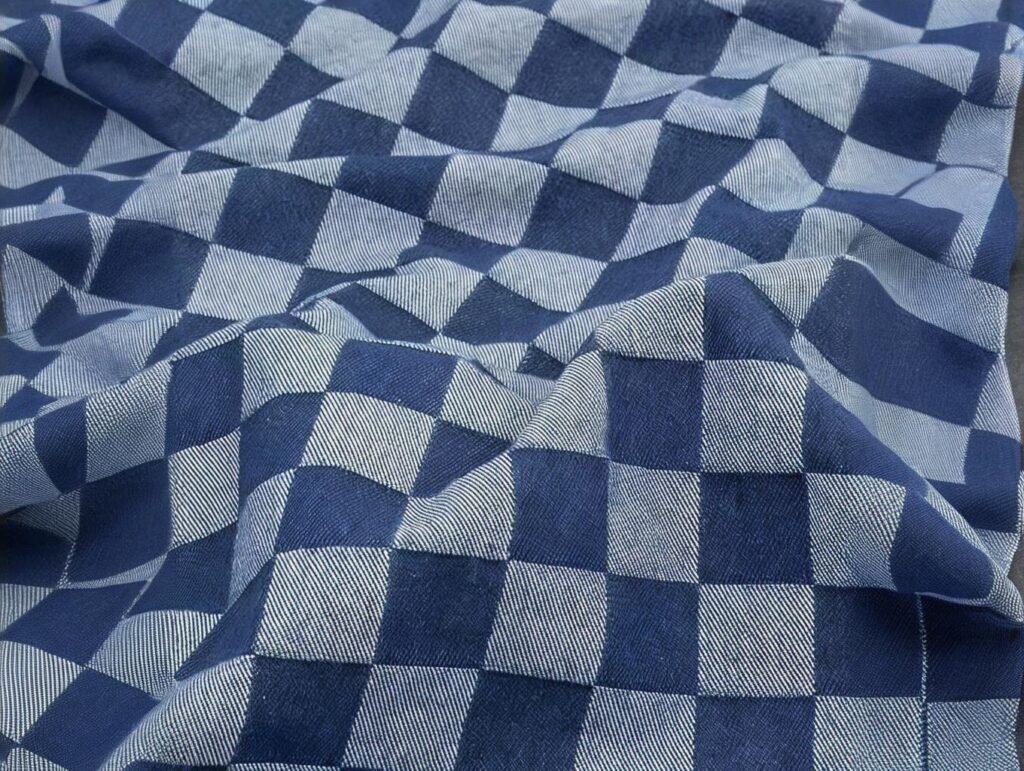
Denim in 2025 is no longer just a fashion staple—it’s a canvas of innovation, sustainability, and cultural relevance. Over the last five years, the global denim fabric market has evolved from commodity-grade basics to a spectrum of premium, functional, and eco-responsible textiles. Driven by shifts in consumer values, technological advancements, and regional growth markets, the denim industry is experiencing a renaissance of reinvention. Global demand for denim fabric has grown significantly from 2020 to 2025, driven by sustainability, innovation in stretch and finish, and increased consumption in fashion and lifestyle sectors. Performance and eco-certified denim fabrics are particularly on the rise.
Key Drivers of Denim Market Growth
1. Eco-Denim Surge: Sustainability Is Now the Standard
Five years ago, “sustainable denim” was a marketing claim. In 2025, it’s a non-negotiable baseline. From organic cotton and recycled yarns to zero-water dyeing technologies, mills are under increasing pressure to prove eco credentials—not only to brands but also to regulatory bodies and end consumers.
According to Statista and Textile Exchange reports:
| Year | Global Denim Market (USD Bn) | % Sustainable Denim |
|---|---|---|
| 2021 | $23.1 | 18% |
| 2023 | $26.8 | 26% |
| 2025 | $29.5 (Projected) | 33% |
Key innovations reshaping eco-denim:
- Laser finishing replacing sandblasting
- Enzyme washes replacing stone washing
- Indigo dyeing with less than 1 liter of water per meter
- Use of natural rubber stretch fibers instead of elastane
Real-World Example: A Japanese boutique denim brand collaborated with a Vietnamese mill to produce 12 oz raw selvedge denim using plant-based indigo and zero-sulfur treatments. The fabric won two regional sustainability design awards and saw a reorder rate of 65% within the first three months.
2. Premiumization of Denim: Elevated Everyday Use
Denim’s image has undergone a high-end rebrand. It’s no longer just rugged—it’s refined. Denim is now found in tailored suits, high-concept jackets, limited edition collaborations, and capsule lifestyle lines.
What’s trending:
- Selvedge denim with bespoke edge branding
- Garment-dyed indigo for a soft, luxurious hand feel
- Over-dye treatments that mimic the fading of decades
- TENCEL™-blended slub denim used in resortwear collections
Luxury houses like Saint Laurent and Amiri have launched full indigo capsules, while direct-to-consumer darlings like Everlane and Nudie Jeans continue to dominate the ethical-luxury denim niche.
Brand Highlight: A Korean menswear label partnered with a Turkish supplier to create a 350 GSM brushed denim with overdye finish, delivering a trouser-level hand feel while maintaining denim’s structure. MOQ was 400m, and the fabric featured in 3 lookbooks across Asia.
3. Regional Expansion: Where the Growth Is Happening
While the U.S. and EU remain denim’s largest legacy markets, much of the new growth is emerging from regions previously underserved by premium denim.
| Region | Key Growth Trends | Buyer Behavior (2025) |
|---|---|---|
| Southeast Asia | Focus on lightweight, soft-stretch fabrics | Fast fashion and e-commerce adoption |
| South America | Eco-washed midweight denim in color variants | Rising demand for workwear + streetwear |
| Sub-Saharan Africa | Imports of raw denim for local production | Hybrid tailoring + traditional uses |
| Middle East | Interest in luxury, modest-cut denim apparel | High-performance blends in demand |
Additionally, online-native brands are placing frequent low-volume orders (100–300m) to test micro-collections, pushing manufacturers to offer fast turnarounds and rapid restocks.
4. Functional Denim: Where Tech Meets Texture
As the fashion world leans further into comfort, hybrid categories, and performance-driven textiles, denim is being reimagined with properties typically reserved for sportswear and outdoor gear.
Hot technical enhancements in 2025:
- 4-way stretch denim for mobility without bagging
- UV-resistant denim for outdoor and tactical use
- Antimicrobial finishes especially in menswear and travel apparel
- Thermoregulating denim for year-round use
| Feature | Common Applications | Avg. Price Range (USD/kg) |
|---|---|---|
| 2-Way Stretch | Skinny jeans, jeggings | $5.80 – $7.20 |
| 4-Way Stretch | Active denim, kidswear | $6.50 – $8.00 |
| Antimicrobial Denim | Travel wear, medical uniforms | $6.80 – $9.00 |
| Thermoregulating | All-season pants & jackets | $7.50 – $10.00 |
Case Study: A Los Angeles-based men’s activewear brand launched a 9.5 oz bi-stretch denim with 20% stretch, antimicrobial finish, and GRS certification developed by a Turkish mill. MOQ: 350m. They launched via Kickstarter and pre-sold 8,000 units in under two weeks.
Final Takeaway
Global denim demand is no longer driven solely by mass-market jeans. Today’s buyers seek conscious sourcing, flexible MOQ, and fabrics that perform across fashion and function. Whether you’re launching an e-commerce label or expanding into premium ready-to-wear, the denim options in 2025 are smarter, more sustainable, and more strategic than ever.
Which Countries Are Leading in Denim Fabric Manufacturing in 2025?
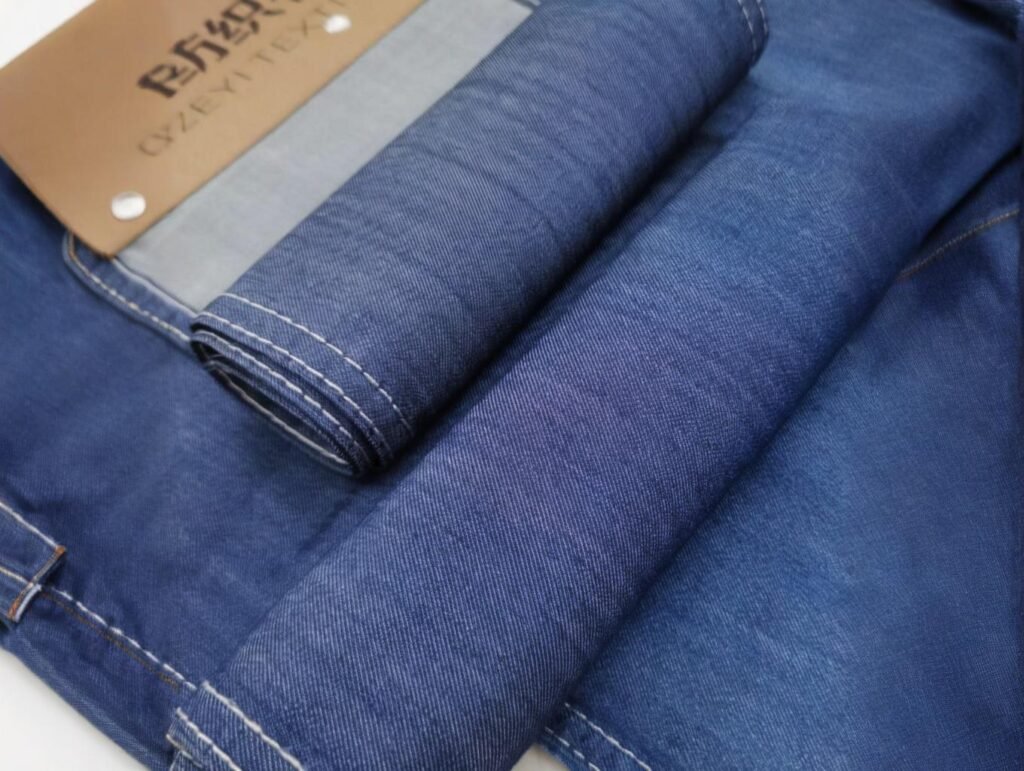
The denim landscape in 2025 is no longer dominated by a single powerhouse. Instead, it’s a multi-hub ecosystem, where different countries serve distinct market needs—from mass-market affordability to luxury-grade craftsmanship, and from hyper-fast delivery to eco-certified innovation. Understanding the regional advantages of each manufacturing base is key to selecting the right partner for your product line. The leading countries for denim fabric manufacturing in 2025 are China, India, Turkey, Pakistan, Japan, and Italy. These countries excel in volume, customization, innovation, and sustainability, catering to diverse market needs ranging from fast fashion to premium denim.
Denim Manufacturing Hotspots in 2025
China: The Backbone of Global Denim Supply
China remains the largest volume producer of denim in the world—and in 2025, it’s not just about scale, but also speed and sophistication.
- Strengths: Wide GSM range, ultrafast prototyping (5–7 days), high capacity (100,000+ meters/month)
- Specialties: Stretch denim with T400 or Lycra, pigment-dyed coated denim, digitally printed indigo
- Tech Integration: Widespread use of automated dyeing machines, laser finishing lines, and waterless wash tech
- Case Example: A New York-based casualwear brand worked with a Guangzhou mill to co-develop 10 oz reactive stretch denim with silicone softener finish, 400m MOQ, and 12-day lead time.
| Feature | Value |
|---|---|
| Avg. Lead Time | 10–15 working days |
| MOQ for Custom Denim | 300–500m |
| Certifications Common | OEKO-TEX, GRS, ISO9001 |
India: Organic, Ethical, and Vertical
India leads when it comes to organic cotton denim and vertically integrated production models. Ginning, spinning, weaving, dyeing, and finishing often happen under one roof, which supports traceability and tight QC management.
- Strengths: GOTS-certified organic denim, skilled artisan weaves, hybrid cotton-poly blends
- Specialties: Lightweight 8–10 oz denims for tropical climates, plant-based indigo, enzyme-washed finishes
- Sustainability Leadership: Mills like Arvind, KG Fabriks, and Raymond have pioneered zero-discharge effluent and low-impact processing
Case Example: A Canadian denim startup sourced GOTS-certified 12 oz rigid denim with 20% hemp content from a Mumbai-based supplier. The fabric passed REACH compliance and hit a reorder rate within 2 months of launch.
| Metric | India |
|---|---|
| Avg. MOQ | 200–300m |
| Sampling Time | 7–10 days |
| Eco Cert Coverage | GOTS, BCI, OEKO-TEX |
Turkey: Agile, Trend-Driven, and EU-Proximate
Turkey is 2025’s go-to destination for trend-forward denim development, thanks to its geographic proximity to Europe and strong textile culture.
- Strengths: High-stretch performance denims, fast fashion response cycles, EU logistics ease
- Specialties: Yarn-dyed slub denim, selvedge, metallic-foil finishes, laser-wash friendly fabrics
- Eco Innovations: Many Turkish mills (like ISKO and Orta Anadolu) are pioneering recycled water finishing and closed-loop dye houses
Case Example: A Dutch streetwear label chose a Turkish mill to develop a TENCEL™/cotton 9 oz denim with oil-wash finish, allowing shipment to EU warehouse within 8 days from sampling approval.
| Metric | Turkey |
|---|---|
| Avg. MOQ | 250–500m |
| EU Delivery Time | 7–10 days |
| Differentiator | High-fashion finishes + rapid lead time |
Pakistan: Cost-Effective and Vertically Integrated
Pakistan is known for its competitive pricing, but it’s also investing heavily in green technologies and vertical operations.
- Strengths: Midweight to heavyweight rigid denim (10–14 oz), reactive/sulfur dyeing, low-cost organic denim options
- Sustainability: Mills like Artistic Milliners and Soorty have implemented LEED-certified facilities and solar-powered washhouses
- Price Point: One of the most budget-friendly sources for mid- to high-volume orders
Case Example: A European hospitality brand sourced 11 oz raw denim with antibacterial silver finish for aprons and utility wear. MOQ: 600m, with full ISO and GRS paperwork provided.
| Factor | Value |
|---|---|
| Avg. Price (USD/m) | $2.30 – $3.80 |
| Sustainability Focus | GRS, ZDHC, HIGG Index |
| Primary Strength | Mid-range bulk + innovation |
Japan: The Artisan Capital of Denim
Japan is revered for heritage-quality denim. Using shuttle looms, rope-dyeing, and slow-craft methods, Japanese mills produce the world’s most sought-after selvedge fabrics.
- Strengths: Low-speed production, small-batch exclusivity, rich slub textures
- Specialties: 13–16 oz raw selvedge, ring-spun rope-dyed denim, irregular weft yarns
- Culture Meets Craft: Denim here isn’t just a textile—it’s a tradition
Case Example: A U.S. boutique jeans brand collaborated with Kaihara to develop a limited-edition 14 oz indigo denim with green selvage ID. MOQ was just 150m per color, shipped with full loom origin documentation.
| Feature | Japan |
|---|---|
| MOQ (Avg.) | 100–200m |
| Price Range (USD/m) | $7.00 – $11.00 |
| Buyer Type | Collectors, luxury, heritage brands |
Italy: Luxury-Grade Innovation with Sustainability DNA
Italy blends high fashion design with textile science, creating denim that supports runway-level aesthetics and next-gen environmental compliance.
- Strengths: Silky denim blends, biodegradable coatings, fashion-first finishes
- Sustainability Excellence: Brands like Candiani lead the world with Blue Seed cotton, Kitotex® finishing, and biodegradable stretch denim
- Design Focus: Custom texture development, color layering, enzyme-print finishes
Case Example: A Scandinavian high-end denim label sourced 11 oz biodegradable stretch denim with peach-skin finish from Candiani. The fabric was showcased at Copenhagen Fashion Week 2025 and praised for “future-proofing denim.”
| Metric | Italy |
|---|---|
| Avg. MOQ | 300–400m |
| Customization Level | Very high |
| Eco Certs | Bluesign®, ZDHC, ISO14001 |
Final Comparison Table: Where Should You Source From?
| Country | Best For | Lead Time | MOQ | Sustainability Rating |
|---|---|---|---|---|
| China | Mass production, fast shipping | 10–15 days | 300m | ★★★☆☆ |
| India | Organic & artisan blends | 7–12 days | 200m | ★★★★☆ |
| Turkey | EU-bound fast fashion | 7–10 days | 250m | ★★★★☆ |
| Pakistan | Cost-sensitive bulk | 10–18 days | 500m | ★★★☆☆ |
| Japan | Selvedge and premium retail | 14–20 days | 100m | ★★★★☆ |
| Italy | Luxury & R&D-grade denim | 10–15 days | 300m | ★★★★★ |
What Types of Denim Fabrics Are Most Popular in Commercial Use?

In 2025, denim isn’t a one-size-fits-all textile. Brands now select denim not just by weight, but by touch, sustainability narrative, user performance, and custom finishing options. Whether you’re launching a gender-fluid capsule, performance jeans, or utility apparel, the right denim base determines both product quality and customer satisfaction. The most popular denim fabrics in 2025 include 10–12 oz stretch denim for fashion, 13–14 oz rigid denim for workwear, lightweight 6–8 oz denim for shirts, and sustainable blends such as TENCEL™-cotton or recycled denim.
Commercial Denim Categories & Trends
Let’s explore the five most in-demand denim types and their role in the commercial garment industry. Each category reflects a broader market shift—from comfort innovation to planet-positive fashion.
1. Lightweight Denim (6.5–9 oz)
Once considered niche, lightweight denim is now widely used in fashion-forward and comfort-driven lines.
- Applications: Summer shirts, wrap dresses, women’s blouses, children’s clothes, and loungewear pants.
- Fabric Characteristics: Drapes well, breathable, suitable for warm climates.
- Popular Blends:
- Cotton-TENCEL™ (for silky finish and cooling effect)
- Cotton-viscose (for softness and affordability)
Data Insight: Global demand for sub-200 GSM denim increased by 38% from 2022 to 2025, especially in tropical markets like Southeast Asia and South America.
| Spec | Value |
|---|---|
| Weight | 180–240 GSM (6.5–9 oz) |
| Avg. MOQ | 300m |
| Custom Finish | Enzyme wash, stonewash, softener finish |
2. Midweight Denim (10–12 oz)
This category remains the backbone of mainstream denim fashion, especially for stretch-based jeans and casual outerwear.
- Applications: Skinny jeans, mom jeans, utility jackets, relaxed trousers.
- Features: Excellent shape retention, adaptive fit, perfect for laser aging and digital abrasions.
- Innovations:
- Bi-stretch (4-way stretch)
- Core-spun yarns with Lycra or T400
- Peach-skin touch via micro-sanding
Case Insight: A German fashion retailer partnered with a Chinese mill to develop a 10 oz comfort-stretch denim with OEKO-TEX® certification. MOQ: 500m. Result: They cut returns by 17% due to fit retention.
| Spec | Value |
|---|---|
| Weight | 260–320 GSM (10–12 oz) |
| Lead Time | 10–15 days |
| Key Finishes | Laser-ready, sulfur dyed, overdye, softened |
3. Heavyweight Denim (13–15 oz)
Heavier denims are associated with durability, premium positioning, and raw denim enthusiasts.
- Applications: Selvedge jeans, cargo pants, aprons, workwear, and fashion-forward utility pieces.
- Attributes: Dense weave, natural fading over time, long lifespan.
- Popular Features:
- Slub yarns for vintage texture
- Rope-dyed indigo for deep saturation
- Low-tension weaving for “open” denim feel
Artisan Case: A Japanese denim house used a 14 oz selvedge from Okayama to create a limited run of 200 pairs for a London designer. The denim had hand-finished seams and custom selvage IDs with recycled polyester threads.
| Spec | Value |
|---|---|
| Weight | 350–400 GSM (13–15 oz) |
| Ideal Buyers | Denim collectors, utility fashion brands |
| Custom Options | Rope dyeing, raw resin, heavy twill |
4. Eco-Performance Denim
This is the fastest-growing category—combining green sourcing with technical features for daily and active lifestyles.
- Applications: Stretchy yoga jeans, travel-friendly denim, commuter-wear, uniforms.
- Material Innovations:
- GRS-certified viscose
- Post-consumer recycled cotton
- Bio-based core yarns
- Popular Finishes:
- Anti-odor
- UV-resistant
- Wrinkle recovery
- Breathable coatings
Global Insight: According to WGSN, denim fabrics labeled as “performance + eco” saw a 52% rise in purchase orders from 2022 to 2024, driven by millennial and Gen Z brand initiatives.
| Feature | Detail |
|---|---|
| Weight Range | 220–300 GSM |
| MOQ | 350–500m |
| Certifications | GRS, ZDHC, OEKO-TEX® |
| Price Range | $3.90 – $6.80/m depending on blend |
5. Printed & Yarn-Dyed Denim
While classic indigo remains strong, visual storytelling through prints and yarn-dyes is trending in fashion-forward categories.
- Applications: Kidswear, resort wear, patchwork jeans, logo-dyed capsule pieces
- Finishing Techniques:
- Digital sublimation printing
- Block pigment dye
- Reactive yarn-dyed check/stripe designs
Creative Insight: An Australian boutique label used 300m of 220 GSM yarn-dyed blue-and-white check denim for a limited “Nantucket” collection. Result: 90% sell-through in the first month.
| Type | Key Specs | |
|---|---|---|
| Printed Denim | 200–280 GSM | Digital, sublimation, pigment |
| Yarn-Dyed Denim | 220–300 GSM | Stripe/check/engineered yarn |
| MOQ (Printed) | 300–500m | |
| MOQ (Yarn-Dyed) | 400–600m |
Additional Trends Worth Watching:
- Color Denim Resurgence: Earth-tone dyed denim (sand, olive, rust) is taking off in 2025, especially in Europe.
- Wide Loom Widths (up to 180 cm): Enables more efficient cutting for brands with wide-leg or oversized silhouettes.
- Foil, Wax, and Reflective Finishes: Popular in streetwear and safetywear hybrids.
Commercial Denim Types at a Glance
| Fabric Category | Oz/GSM | Key Buyers | Functional Traits | Common MOQ |
|---|---|---|---|---|
| Lightweight | 6.5–9 oz | Fashion brands | Soft, breathable, drapey | 300m |
| Midweight Stretch | 10–12 oz | Denim-focused lines | Comfort fit, stretch, laser finish | 300–500m |
| Heavyweight Rigid | 13–15 oz | Workwear, selvedge buyers | Tough, vintage appeal | 400–800m |
| Eco-Performance | Varies | Activewear, lifestyle | Recycled, odor-control, moisture-wicking | 350–500m |
| Printed/Yarn-Dyed | 6.5–11 oz | Designers, kidswear | Visual texture, novelty appeal | 300–600m |
How Do Denim Fabric Customization Options Vary by Supplier?
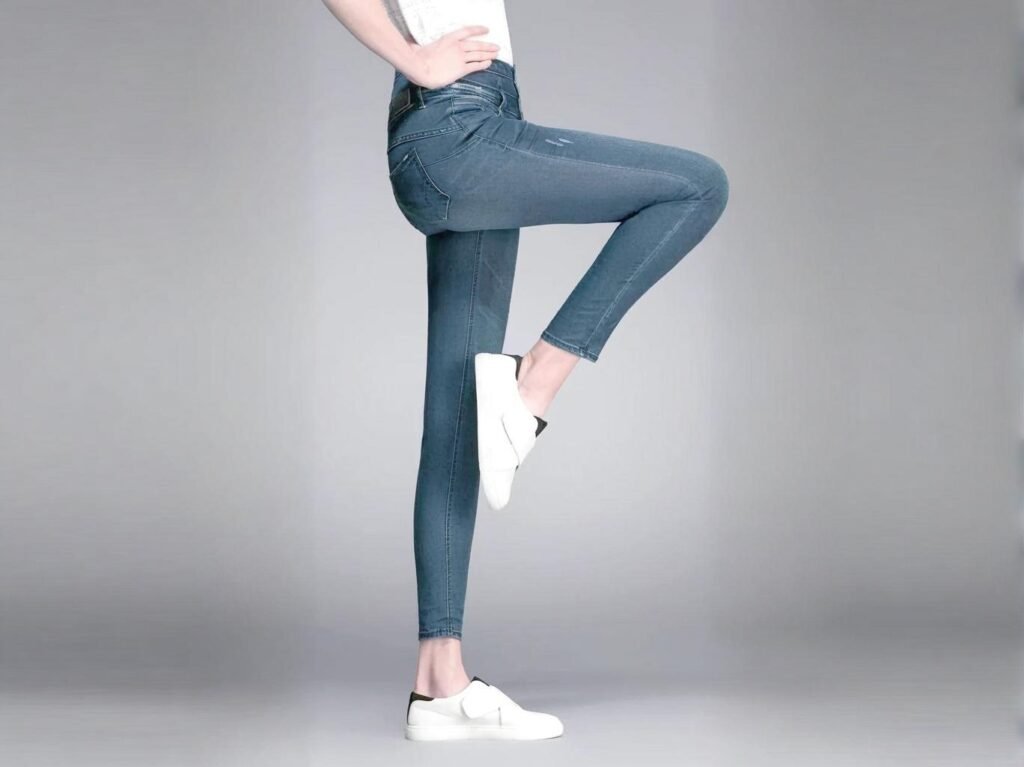
Customization in 2025 is a core demand from fashion labels and industrial brands alike, not a luxury. Whether it’s tailoring fabric weight, selecting indigo shades, adjusting elastane percentage, or choosing an eco-finishing method, denim mills that can offer flexibility gain a major competitive edge. Denim customization options vary by supplier, with premium mills offering detailed adjustments in GSM, yarn type, weave, stretch level, dyeing methods, and sustainable finishes. Larger Asian factories lead in rapid customization and low MOQ, while European mills offer elite finishing and traceable blends.
Dimensions of Denim Fabric Customization
1. GSM & Weave Type Customization
- Suppliers in China and India typically allow +/-10 GSM tolerance.
- Buyers can specify twill styles: 2/1 (soft drape), 3/1 (firm hand), broken twill (anti-leg twist).
- Some mills offer slub pattern customization (e.g., irregular yarns for vintage aesthetics).
| Fabric Spec | Supplier Flexibility | MOQ Requirements |
|---|---|---|
| GSM (Weight) | 180–400 GSM available; 10 GSM step | As low as 300m |
| Weave Structures | 2/1, 3/1, broken twill, dobby | 300–500m |
| Slub Yarn Level | Light, medium, heavy slub | 500m+ (usually custom spin) |
2. Stretch & Yarn Configuration
- Elastane content can be specified: 1%, 2%, or dual-core (Lycra® T400).
- Core-spun or open-end yarns are adjustable for softness vs durability.
- Many Indian and Turkish suppliers offer bi-stretch capabilities under 500m MOQ.
3. Indigo & Dyeing Control
- Reactive, sulfur, rope, and foam dyeing techniques can be selected.
- Tone depth: light wash, medium vintage, deep raw, black overdyed.
- Shade control via lab dip approvals within 5–7 days is standard for serious suppliers.
4. Finishing Techniques
- Enzyme, silicone-soft, ozone, resin, wrinkle-free, or waterproof coatings.
- Laser-etch readiness or 3D whisker pattern testing.
- Some Italian and Japanese mills allow “pre-distress” simulation at the fabric stage.
Case in Point: A UK-based designer label collaborated with a Chinese denim supplier to create a 12 oz dual-core stretch denim with deep black overdyed rope indigo and a silicone enzyme softening finish. The mill provided lab dips + swatch testing in 6 days and fulfilled 800 meters in under 3 weeks.
What Are the Typical MOQ and Lead Time When Ordering Denim in Bulk?
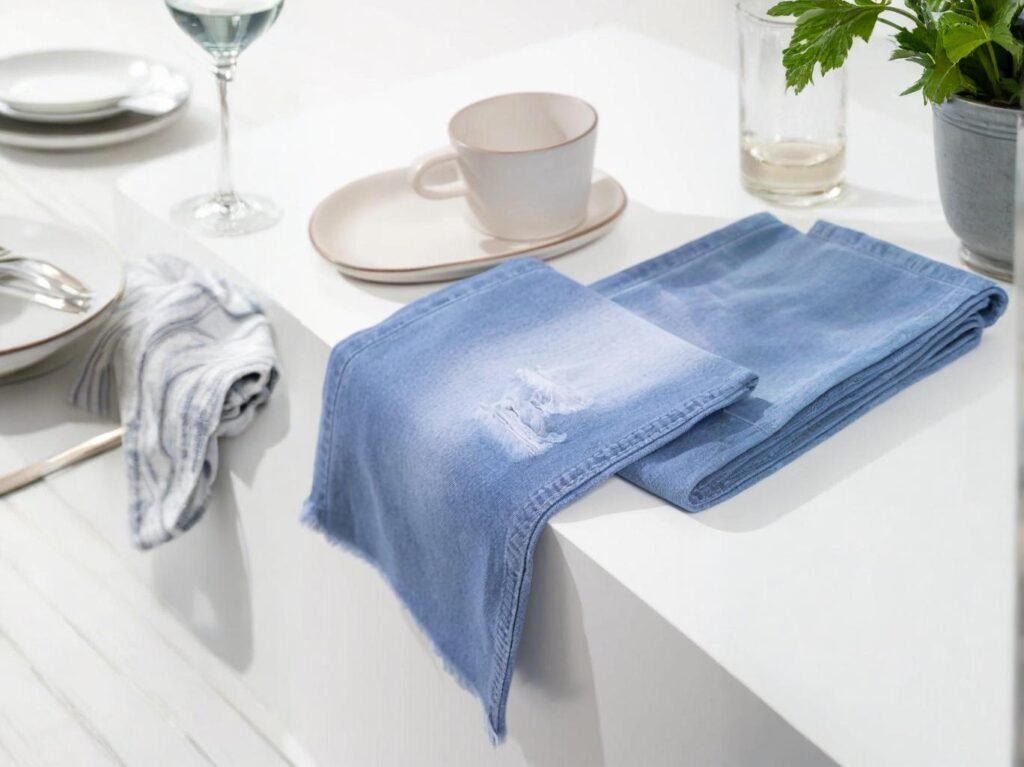
Whether you’re launching a 100-piece capsule or a 10,000-unit commercial collection, MOQ (Minimum Order Quantity) and lead time remain critical factors in planning your production pipeline. In 2025, denim suppliers are responding to market pressures by offering lower MOQs, quicker turnaround, and flexible customization—yet the actual figures still vary greatly depending on region, fabric type, finish, and factory workflow. Typical denim MOQ in 2025 ranges from 200 to 1000 meters depending on fabric complexity. Standard lead times are 12 to 30 days, with premium or custom finishes adding 5–10 extra days. Most top suppliers now offer sampling in 5–7 business days.
MOQ & Lead Time by Region and Supplier Type
Here’s a comparative view of standard commercial denim lead times and MOQ thresholds across major producing regions:
| Country | MOQ (Standard Denim) | MOQ (Custom Blend or Dye) | Sample Lead Time | Bulk Production Lead Time |
|---|---|---|---|---|
| China | 300–500 meters | 500–1000 meters | 5–7 business days | 15–25 business days |
| India | 200–400 meters | 400–800 meters | 6–8 business days | 18–30 business days |
| Turkey | 200–300 meters | 300–600 meters | 5–7 business days | 12–20 business days |
| Japan | 100–300 meters | 300–600 meters | 10–15 business days | 30–45 business days |
| Italy | 300–600 meters | 500–1000 meters | 7–10 business days | 25–35 business days |
| Pakistan | 400–800 meters | 800–1500 meters | 5–8 business days | 18–30 business days |
Factors That Influence MOQ and Lead Time
Let’s explore the real-world factors that determine how quickly you can receive your fabric and how much you’re expected to order per style or color.
1. Fabric Complexity & Fiber Content
- Simple 100% cotton denims with no finish can be sampled and produced faster than blended or finished fabrics.
- Stretch or core-spun yarns (TENCEL™, spandex, GRS poly) require longer yarn prep time.
Tip: If your fabric includes Lycra, polyester core, or recycled viscose, expect +3 to 5 extra production days.
| Blend Type | Lead Time Impact |
|---|---|
| Cotton Only | Fastest |
| Cotton + Spandex | +3–4 days |
| TENCEL™/GRS + Stretch | +5–7 days |
| Core-Spun Performance Denim | +7–10 days |
2. Finishing Treatments
Special finishes dramatically affect both sample time and MOQ:
- Enzyme wash: +2 days
- Bio-softening or anti-odor: +4 days
- Laser/ozone wash compatibility testing: +3–5 days
- Coatings or resin: +5–8 days
3. Dyeing & Color Development
Color matching and lab dips are bottlenecks if not planned well.
- Rope dyeing: Adds 8–10 days due to batch prep
- Reactive dyeing: +4 days
- Pigment dyeing: +3 days
- Sulfur dyeing: Most efficient (used heavily in mid-range)
Pro Tip: Ask if your supplier keeps pre-dyed archive bases—this can reduce turnaround by up to 6 days for repeat styles.
4. Supplier Type and Workflow Setup
- Vertical mills (like those in Pakistan or India) can integrate spinning, dyeing, and weaving, allowing shorter turnaround and lower MOQ on custom orders.
- Artisan or legacy mills (Japan, Italy) focus more on craftsmanship, often needing longer lead times but offering exclusive quality and brand appeal.
Fast Sampling Solutions by Country (2025)
| Country | Sampling Speed | Notes |
|---|---|---|
| China | 5–7 days | Often includes both fabric swatch and lab dip |
| Turkey | 5–6 days | Digital finishing simulations also available |
| India | 6–8 days | Includes 2–3 base variants and dye trial |
| Japan | 10–15 days | Pre-woven archive bases available for faster decision |
| Italy | 7–10 days | Includes certificate of origin + pre-treated options |
Real Client Example: Blended Denim Efficiency
Client: A Scandinavian slow-fashion label Fabric Ordered: 9 oz cotton-TENCEL™-spandex blend Supplier: Mid-sized Turkish denim mill MOQ: 250 meters (for two colors) Sampling: 6 working days Production Lead Time: 16 days Extras: Included reactive dyeing, softener finish, and hangtag certification for GRS/TENCEL™
Result: Brand completed entire product development + production + labeling within 5 weeks, allowing them to meet their spring collection launch timeline.
Lead Time by Denim Type
| Denim Type | Sample Time | Bulk Lead Time | MOQ |
|---|---|---|---|
| Basic Cotton (No Finish) | 5–6 days | 12–15 days | 300m |
| Stretch Midweight Denim | 6–8 days | 16–25 days | 400–600m |
| TENCEL™ or Recycled Blends | 7–9 days | 20–30 days | 500m |
| Heavyweight Selvedge | 10–14 days | 25–45 days | 100–300m |
| Coated or Printed Denim | 8–10 days | 20–35 days | 400–700m |
Additional Sourcing Tips for MOQ and Lead Time:
- Batch similar weights across styles to reduce MOQ per color.
- Always request pre-bulk shrinkage data to avoid post-production fit issues.
- Discuss roll width early—wider rolls (up to 180cm) reduce yardage needed for cutting.
What Certifications Should Denim Suppliers Have in 2025?
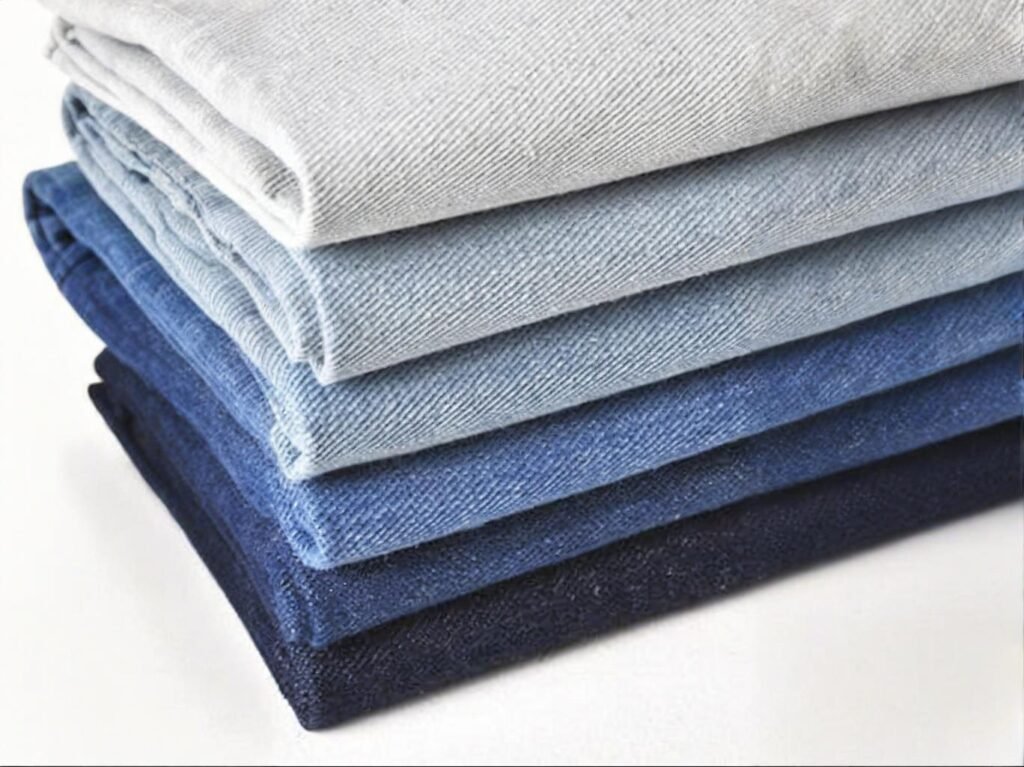
Today’s denim industry isn’t just about GSM, shrinkage, or indigo hues—it’s about credibility, accountability, and transparency. Buyers in 2025 must assess not just what fabric is made of, but how it’s made, by whom, and under what conditions. Whether you’re sourcing basic cotton twill or high-performance eco-denim, supplier certifications are now a strategic requirement, not just a bonus. Key denim certifications in 2025 include OEKO-TEX® Standard 100, GOTS, GRS, BCI, and ISO 9001/14001. These ensure fabric safety, organic content, recycled material traceability, ethical sourcing, and high production standards—critical for responsible sourcing and global compliance.
Denim Supplier Certifications in Detail
Let’s take a closer look at each major certification and what it represents to buyers and global regulators.
1. OEKO-TEX® Standard 100 – The Chemical Safety Baseline
OEKO-TEX® is one of the most widely recognized textile certifications, ensuring that no harmful substances are present in finished denim goods. This covers:
- Heavy metals (like lead, nickel)
- Azo dyes and formaldehyde
- Phthalates (often found in coatings)
- Allergenic dyes
Most global clothing brands will not accept denim that doesn’t meet this baseline certification.
Bonus Insight: OEKO-TEX® certification is batch-specific. Request a current certificate tied to your production run (valid for 12 months).
2. GOTS – Global Organic Textile Standard
For any denim made with organic cotton, GOTS is the gold standard. But it’s not just about the cotton itself—it audits the entire supply chain, including:
- Organic fiber verification
- Wet processing chemicals
- Wastewater treatment
- Worker rights and social conditions
Applicable to: Luxury, eco, or wellness-driven fashion lines.
Note: To use the GOTS logo on your final garment, every supplier from yarn spinner to dyer to weaver must also be certified.
3. GRS – Global Recycled Standard
As circular fashion gains steam, GRS becomes essential for any denim containing:
- Pre-consumer recycled cotton
- Post-consumer jeans or fabric scraps
- Recycled polyester/spandex in stretch denim
Chain-of-Custody Auditing: GRS ensures all recycled inputs are traceable and certified across processing stages, from raw material to finished fabric.
Emerging Trend: “Jeans-to-jeans” programs now require GRS-compliant mills to maintain full recyclability tracking.
4. BCI – Better Cotton Initiative
BCI is an entry-level sustainability credential used by many mass-market retailers. It certifies farming practices that focus on:
- Reduced pesticide and water usage
- Improved soil health
- Fair labor practices for farmers
Clarification: BCI is not equivalent to organic—but it’s a more affordable, scalable option for denim lines that can’t meet GOTS thresholds.
Label Use: Brands must register with BCI to legally reference it on packaging or labels.
5. ISO 9001 & ISO 14001 – Internal Mill Management
These ISO standards don’t govern product content but rather the systems behind the fabric:
- ISO 9001: Focuses on quality control systems, SOPs, and risk management
- ISO 14001: Governs environmental impact, water/waste treatment, emissions
Buyer Tip: ISO-certified factories often produce more consistent fabric with lower defect rates and better documentation.
Denim Certifications at a Glance
| Certification | Focus Area | Ideal For | Buyer Requirements |
|---|---|---|---|
| OEKO-TEX® 100 | Final fabric safety | All apparel brands | Mandatory for babywear, EU imports |
| GOTS | Organic integrity + social compliance | Premium/eco fashion | Full chain certification |
| GRS | Recycled fiber tracking | Circular fashion, eco denim | Needed for “recycled” label claims |
| BCI | Cotton farming standards | Mass-market production | Registered brand partnership |
| ISO 9001/14001 | Factory quality + environmental systems | All regions | Signals professional mill management |
Case Study: Multi-Certified Mill for Circular Denim
Client: A French premium denim label Product: 11 oz denim using 60% post-consumer recycled cotton Supplier: A Chinese mill certified with GRS, OEKO-TEX, and ISO 14001Approach:
- Full chain-of-custody provided for GRS compliance
- Chemical safety report from OEKO-TEX lab submitted pre-shipment
- Wastewater logs validated under ISO 14001 audit
Result: The brand successfully used all certifications to clear customs in both the EU and U.S., added certified hangtags, and earned press coverage for their “closed-loop jeans” concept.
Certifications Emerging in 2025 (Worth Watching)
Besides the staples above, here are newer certifications gaining traction in denim supply:
- ZDHC (Zero Discharge of Hazardous Chemicals): Focuses on chemical usage and wastewater. Especially important for finishing and dye houses.
- Bluesign®: Verifies safe chemical inputs and energy-efficient processes. Common in sportswear/activewear denim.
- SA8000: Addresses social responsibility in manufacturing—popular with European and American fashion buyers.
- Higg Index (by SAC): While not a certification, Higg allows brands to score mills on environmental and social metrics.
Real-World Tips for Certification Verification
Always ask for the cert number and expiration date. Cross-check on official registries like OEKO-TEX’s certificate checker or GOTS public database.
Label Compliance: If your end garment will feature the certification label, you must work with a fully certified supply chain—including sewing units, not just fabric mills.
Watch for greenwashing: Phrases like “eco-friendly denim” or “sustainable cotton” are meaningless without third-party certification.
Must-Have vs. Optional Denim Certifications
| Certification | Must-Have | Optional/Value Add |
|---|---|---|
| OEKO-TEX® | ✅ Yes | — |
| GOTS | ✅ (for organic) | — |
| GRS | ✅ (for recycled) | — |
| BCI | ✅ (for responsible cotton) | — |
| ISO 9001 | ✅ Yes | — |
| ISO 14001 | ✅ Yes | — |
| ZDHC | — | ✔ Emerging essential |
| Bluesign® | — | ✔ Adds brand value |
| SA8000 | — | ✔ Social compliance |
| Higg Index | — | ✔ Brand-side audit tool |
Who Are the 20 Best Denim Fabric Manufacturers Trusted by Global Buyers?
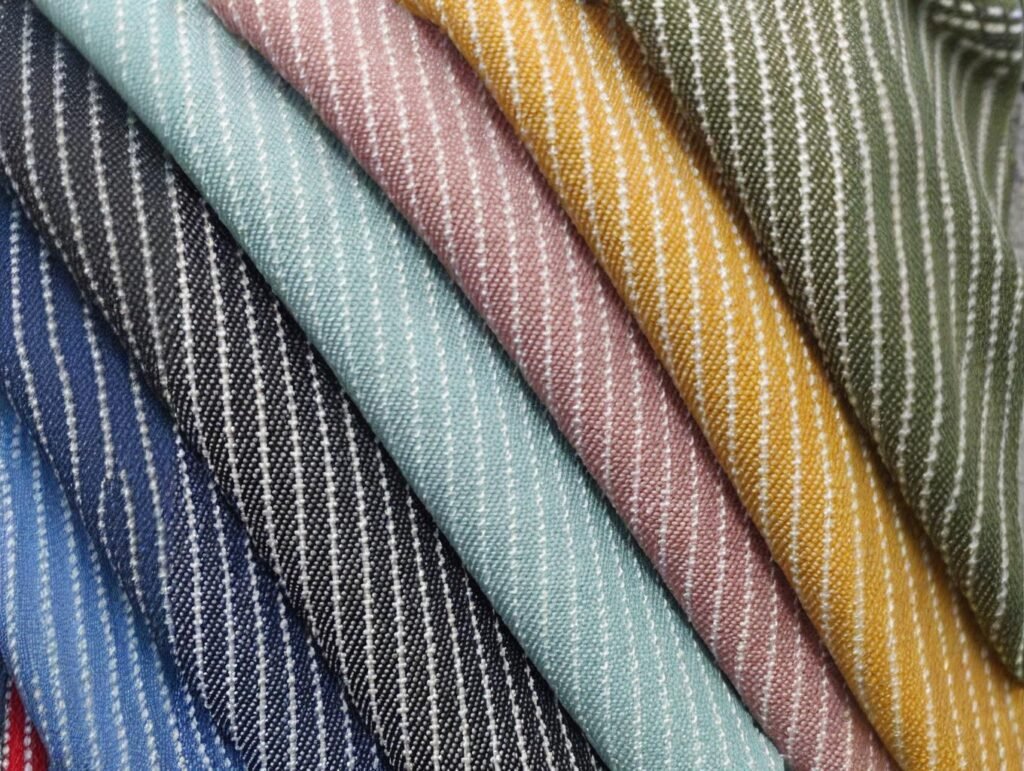
In 2025, denim is more than a material—it’s a brand foundation. The top denim manufacturers are not simply weaving mills—they are innovation hubs, sustainability leaders, and trusted partners in global fashion supply chains. Whether you’re developing raw selvage jeans, circular capsule collections, or flexible lifestyle denim, these 20 suppliers represent the best-in-class resources worldwide. The best denim fabric manufacturers in 2025 include globally trusted mills from China, India, Turkey, Japan, Italy, and Pakistan. These suppliers offer superior quality, fast customization, eco-certifications, and excellent service for fashion, workwear, and sustainable denim projects.
Top 20 Global Denim Fabric Manufacturers
| No. | Manufacturer | Country | Core Strengths | MOQ | Key Certifications |
|---|---|---|---|---|---|
| 1 | SzoneierFabrics | China | Custom development, fast sampling, low MOQ | 200m | OEKO-TEX®, GRS |
| 2 | Arvind Ltd. | India | Vertical production, recycled/organic blends | 500m | GOTS, OEKO-TEX®, ISO |
| 3 | Candiani Denim | Italy | Biodegradable denim, laser-ready finishes | 300m | GRS, ISO 14001, GOTS |
| 4 | Prosperity Textile | China | Performance denim, rope dyeing expertise | 500m | OEKO-TEX®, ISO |
| 5 | Orta Anadolu | Turkey | Solar-powered mill, circular textile R&D | 300m | GOTS, GRS, BCI |
| 6 | Artistic Milliners | Pakistan | LEED Gold mill, recycled jeans-to-jeans denim | 1000m | GOTS, GRS, OEKO-TEX® |
| 7 | Calik Denim | Turkey | Reactive dye tech, trend-driven textures | 400m | OEKO-TEX®, BCI |
| 8 | Kuroki Co., Ltd. | Japan | Shuttle loom selvage denim, rope-dye legacy | 100m | OEKO-TEX®, ISO |
| 9 | Bossa Denim | Turkey | AI sizing + digital R&D platform | 300m | ISO, OEKO-TEX® |
| 10 | Vicunha Textil | Brazil | Largest mill in South America | 600m | OEKO-TEX®, ISO 9001 |
| 11 | Saitex | Vietnam | Robotic automation, waterless finishing | 500m | GOTS, LEED, OEKO-TEX® |
| 12 | Cone Denim | USA/Mexico | NAFTA supply chain, historic U.S. brand | 300m | OEKO-TEX®, ISO |
| 13 | KG Fabriks | India | Carbon-neutral denim facility | 400m | GRS, ISO, GOTS |
| 14 | Blue Diamond Denim | China | Value pricing with reactive dye expertise | 300m | OEKO-TEX® |
| 15 | Black Peony Group | China | Private label integration, fast development | 500m | OEKO-TEX®, ISO |
| 16 | Denim Expert Ltd. | Bangladesh | Transparent ESG model, ethical factory | 400m | BSCI, OEKO-TEX® |
| 17 | Raymond UCO | India | TENCEL™, stretch innovation | 400m | OEKO-TEX®, ISO |
| 18 | Soorty Enterprises | Pakistan | Circularity, digital prototyping labs | 500m | GOTS, GRS, OEKO-TEX® |
| 19 | Isko Denim | Turkey | ISKO Recall™ and R-TWO™ circular platforms | 500m | GOTS, GRS, ISO |
| 20 | Shin Denim | Japan | Artisan selvedge for premium labels | 100m | ISO, OEKO-TEX® |
Regional Sourcing Insights for Buyers
- China: Best for fast development, price-to-performance ratio, and scaling from 200m+. Great for OEM and ODM with wide GSM options.
- India: Strong in organic and hybrid yarns, GOTS/GRS ecosystem, and mid-size runs. Vertical setups help with transparency.
- Turkey: Excellent for EU logistics, fast fashion timelines, and tech-forward finishes. Trend research and wash innovation hubs.
- Japan: Ideal for heritage denim, slow-woven selvage, and low MOQ premium orders. Best for storytelling-driven brands.
- Italy: A luxury sourcing destination with emphasis on sustainability, soft-hand coatings, and fashion finish R&D.
- Pakistan: Known for value-added circularity, affordable mid-to-heavyweight denim, and increasing adoption of ESG certifications.
Real-World Example: Matching Brand Needs to Supplier Strength
Case 1: Streetwear Capsule in Europe A Berlin-based urban wear brand worked with Orta Anadolu (Turkey) to develop 10 oz sulfur-dyed black denim with 20% recycled cotton. Lead time: 15 days. MOQ: 400m. Custom laser simulation included.
Case 2: Premium Raw Denim Line in the U.S. A New York label partnered with Kuroki (Japan) for 13.5 oz unsanforized selvage denim with red ID tape. MOQ: 100m. Delivered in 28 days with rope-dye batch ID for traceability.
Case 3: Sustainable Workwear for Retailer A Scandinavian retailer collaborated with SzoneierFabrics (China) for a 12 oz cotton-TENCEL™ blend denim with eco-soft enzyme finish and recycled logo selvage. MOQ: 300m, sampling in 6 days, full bulk in 16 days.
Choosing the Right Denim Manufacturer: Buyer Checklist
Before selecting your supplier, make sure to evaluate:
✅ MOQ and lead time flexibility for your stage of business ✅ Certifications that align with your product claims (e.g., GOTS, GRS, OEKO-TEX®) ✅ Customization capabilities like GSM, finishes, and selvage options ✅ Sample turnaround speed (especially if you’re prototyping) ✅ Post-sales support including labeling, documentation, and wash testing
Work with a Denim Mill That Builds With You
In 2025’s competitive fashion environment, your fabric supplier is part of your brand story. These 20 manufacturers aren’t just production partners—they’re collaborators in sustainability, innovation, and growth.
Build Your Brand with SzoneierFabrics
At SzoneierFabrics, we specialize in:
- Low MOQ custom denim (as low as 200m)
- Eco-certified yarns & GRS-based blends
- Enzyme, pigment, and reactive-dyed finishes
- Fast sampling: swatches in 5–7 days
- OEM/ODM services for private label & premium brands
Whether you need soft, laser-ready stretch denim or stiff raw selvage for limited drops—we help you get it right the first time.
Contact SzoneierFabrics now for free development consultation, sample request, and custom pricing tailored to your project.
Let’s co-create denim that your customers will remember.
